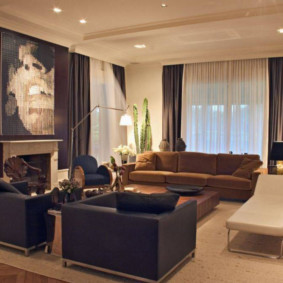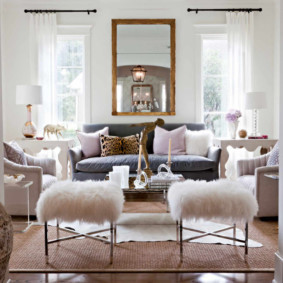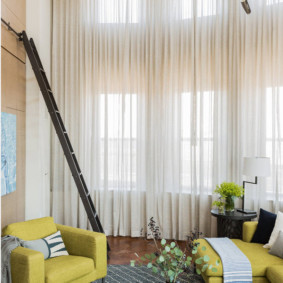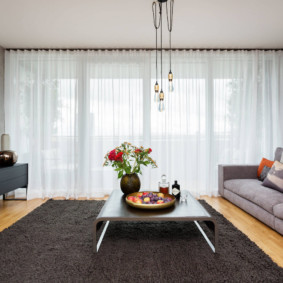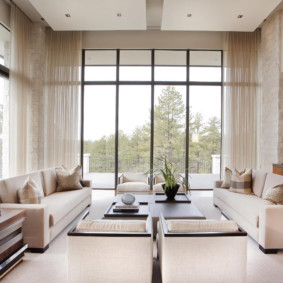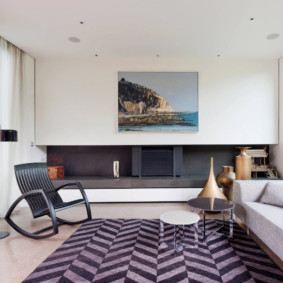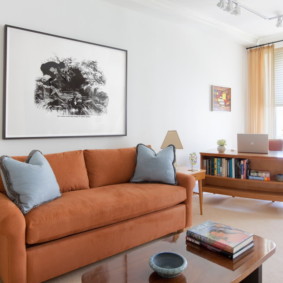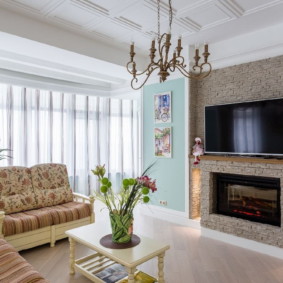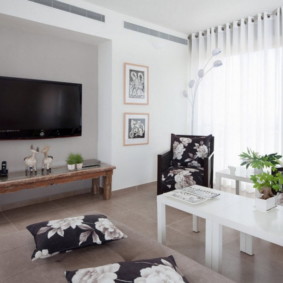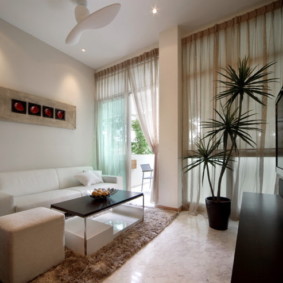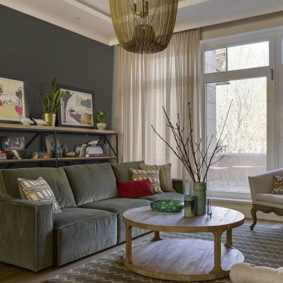 Living room
Mirrors in the interior of the living room
Living room
Mirrors in the interior of the living room
Tulle protects from prying eyes, shades from the sun. But she has another function - decorative. She decorates the room and can transform the interior, even if the color of the walls and furniture remain the same. What materials tulle curtains are made of, what are their advantages and disadvantages, how to choose a color, style and which curtain will work best - read about this in our article.

When choosing a tulle for the hall, it is necessary to take into account the color palette of the interior, the features of the material, the possibility of drapery and decorations
Pros and cons of tulle in the hall
Content
Some believe that tulle and curtains for the hall are an outdated interior detail. Others are sure that without drapery, the windows will look boring and state-owned. To decide whether to hang a tulle in a room or not, you need to consider its advantages and disadvantages.

This airy and weightless material is able to organically complement the interior of the living room and become its key element
Tulle has many advantages in the hall:
- Privacy. Curtains hide visibility for passers-by from the street.
- Sun protection. Direct sunlight can damage furniture. They lead to fading of color, overdrying of the surface. In addition, in a constantly sunlit house in the summer it will be uncomfortable - too hot.
- Battery disguise. The view of the radiator grills does not decorate the apartment, unless, of course, this is a design idea. Therefore, it is better to drape them with a beautiful tulle.
- Window decor. The interior can change dramatically after tulle appears on the windows. It makes the home cozier, more pleasant for relaxation.
- Prevalence. Tulle holds a leading position among other options for dimming windows. Even the popular laconic Roman curtains can not take the palm from the lace curtain. Designers have developed many models of tulle for windows. Everyone can choose a suitable option.
There are fewer minuses than pluses. The main disadvantages of tulle:
- Space reduction. Textiles on the windows visually “eat up” the space of the room.
- Overlap of visibility. The fabric, although translucent, but it does not allow you to fully see the beauty of the landscape outside the window.
- Blackout. Mesh material protects from the sun, but at the same time and reduces the illumination of the room.
Based on the pros and cons of tulle, everyone can decide for themselves whether to buy tulle in the hall or you can do without it.

When selecting a tulle, the room area, ceiling height, size and shape of the window opening are taken into account
Options for tulle materials
Kapron tulles are the most common on the home textile market today. But there are rare materials. For example, jacquard is the most expensive curtain option. It is made from natural materials: cotton, silk or a mixture of these threads. Modern manufacturers offer cheaper analogues from synthetics. In the fashionable eco-direction of design, linen tulle has spread. It does not harm health, transmits light and air, looks harmonious, but easily wrinkles, which complicates care.

Properly selected material for curtains in the hall will not cause trouble with washing
Other types of materials are used:
- cotton;
- silk;
- viscose;
- nylon and lavsan fiber;
- polyamide and polyester chemical fibers.
Sometimes mixed fibers are used in the manufacture of tulle - a combined mixture of cotton or silk fibers with synthetic ones.

For a room with windows on the shadow side, it is better to choose light translucent fabrics.
Different types of tulle materials are made from natural, synthetic or semi-synthetic fibers:
- veil;
- grid;
- organza;
- Kisei.
Each fabric has its own characteristics, strengths and weaknesses.

Dense fabrics of pastel colors are more suitable for sunny windows
Veil
The texture of the material is tender, not too dense, translucent. Soft texture makes it easy to drape it into beautiful folds. It is made from different types of threads: cotton, silk, woolen.

A well-chosen veil can make the room sparkle with new colors, and a bad one can spoil the whole impression.
The fabric is durable, does not accumulate dust, looks beautiful. It transmits light worse than other materials. Therefore, it is often used without curtains. The cons of the veil are poor breathability.
Grid
The texture of the material is mesh, consists of large, medium or small cells. It transmits light and air well. The grid is not used separately. It is always complemented by curtains.
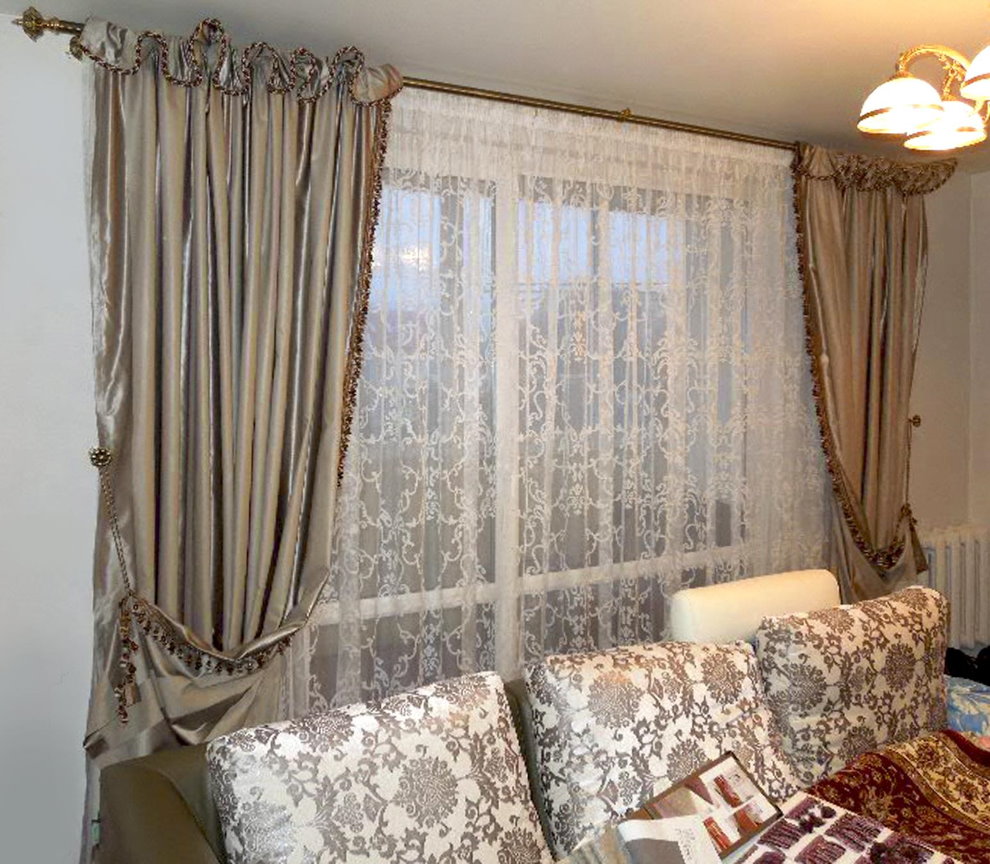
Harmonious mesh combination with blackout curtains
The fabric has many variations of performance:
- cell or rhombus of different sizes;
- French mesh with delicate patterns;
- spider web with a chaotic pattern;
- mesh with embroidery.
In some models, the mesh is decorated with rhinestones, lace or laser trim. Less material - it collects dust very much, which complicates the care of it.
Organza
In fact, this is not a type of fabric, but a special interweaving of threads in it. Organza is made from different materials, which makes it possible to create models in different price categories. It transmits light well, keeps its shape perfectly, durable, strong, does not accumulate dust.

Organza - a strong translucent fabric, perfect for decorating window openings in the hall
Caring for her is simple: she is able to survive multiple machine washings. Of the minuses - it does not allow air to pass through well, some models are expensive.
Kisei
Represents a cloth from separately hanging threads. Made from cotton, synthetics, silk. By design, it can be made in the form of a spiral, threads of "rain", from ribbons, wooden beads, glass beads, with textile decor. The color is plain or color.
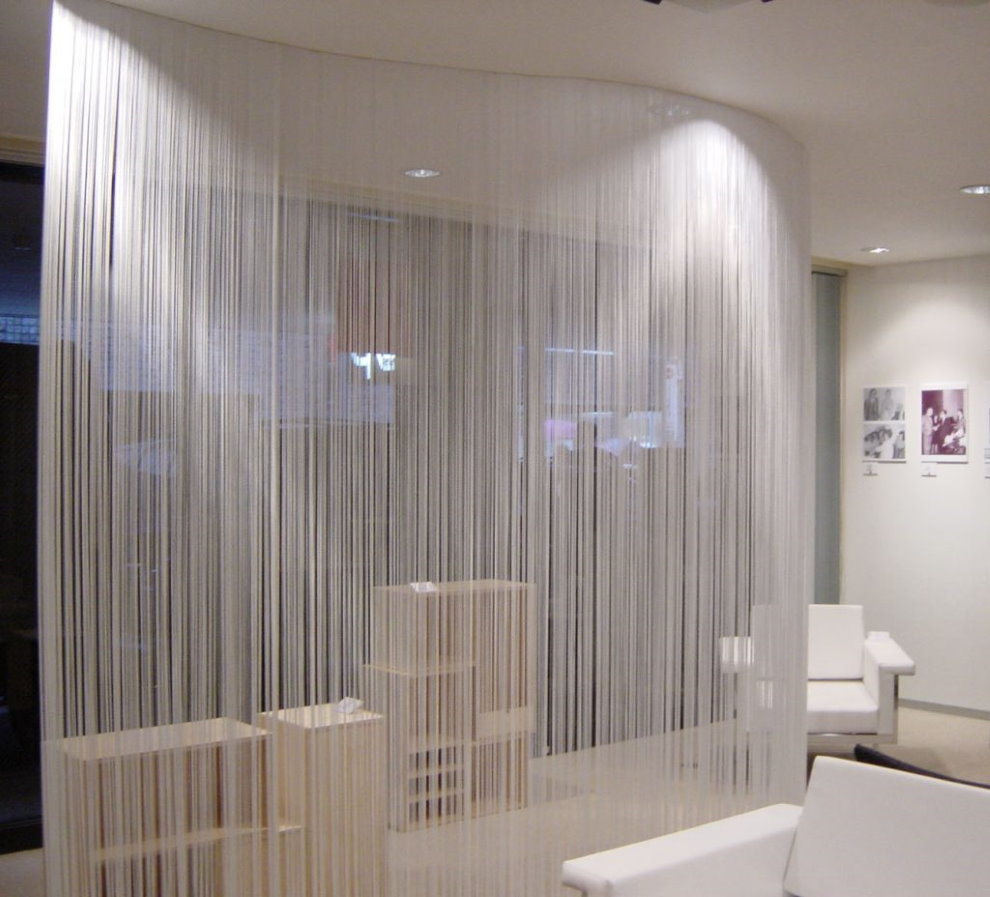
Kiseya is ideal for the role of space separator
Less thread curtains - it can not be a full replacement for tulle. More often, kisene is used for zoning space.
Choice of color scale of tulle
Before choosing a tulle for the hall, you need to determine their color. At the same time, the color in which the walls are decorated should be taken into account:
- White. In this case, designers are not advised to decorate the window with white or milk textiles. Their idea is whitened colors, that is, those in which the main color is diluted with white. Examples of options are pale yellow, pale green, pale red, and so on.

White tulle - a classic solution to create a neutral background for the rest of the interior
- Grassy green. For pistachio, grassy shades of the walls, white tulle is also not suitable. It will create too clear a contrast. The best option would be light beige tones and khaki.
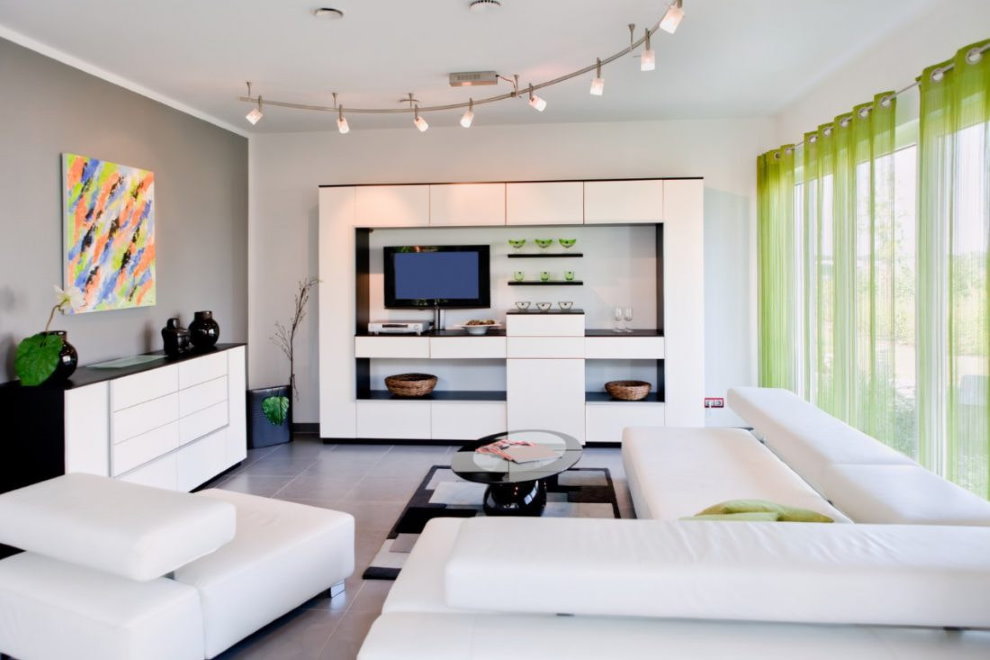
Tulle curtains of green color will cause calm and positive emotions
- Brown. Milky, white or cream curtains harmonize with the brown shades of the walls, depending on the saturation of the chocolate color.

Brown tulle on the living room window with a sofa of the same color
- Gray. Ash color is universal. It is easily combined with almost all other colors of the palette. If the main tone in the room is gray with a cold undertone, then white tulle will suit it. If there are warm tones in the smoky color, it is better to choose cream tulle curtains.The gray color of the walls allows bold experiments in the interior. You can select different shades of tulle to it: purple, green, blue, turquoise, pink.

Gray tone tulle curtains with flooring
- Blue. With blue shades, white tulle creates a beautiful combination. An atmosphere of marine freshness and lightness appears in the interior. Looks good with blue shades of blue.

If the all-blue curtains seem too dark, you can choose a striped tulle
If in doubt, which tulle to choose in the hall, you can turn to the most universal option - sand or beige. They are suitable for any interior. Their calm nature will be in harmony with both soft and expressive colors in the room.
Choosing a curtain rod for tulle
In order for the tulle in the hall to look like in the photo from eminent designers, you need to take care of the cornice. His choice depends on which curtain-tulle composition is selected.

Mounting on the grommets allows you to create neat and beautiful folds that are preserved when moving the tulle along the ledge
Tulle without curtains
If curtains are not provided and you need to hang only tulle curtains, then 2 options for curtain rods are best:
- strings;
- barbell;
- string.
It is a string of strong steel, stretched between two brackets. Curtains and curtains are attached to the string using special hooks or clips. String cornices are suitable for light tissues. They will create the effect of curtains floating in the air. Photos of a beautiful tulle for a hall on a string cornice prove how weightless it looks.

Thanks to its simplicity, string cornices fit perfectly into modern style, hi-tech or minimalism
Pros: simple, robust construction, the effect of soaring in the air, the ability to place a string cornice not only above the windows, but also between them.
Cons: can not withstand heavy fabrics, metal strings easily corroded.
Barbell
Outwardly, the cornice looks like a round metal pipe with rings and clamps. It happens of different types:
- classic
- arched;
- angular;
- sliding;
- for curtains "cafe".
There are also typesetting rod cornices. Their feature is that you can choose all the components of the console yourself.

You can fix the tulle curtain on the bar with the power of rings, clothespins, eyelets or fabric garters
Pros: easy installation, simple design, a wide range of models, compatibility with most interior styles, high strength - withstand heavy curtains and complex draperies, durability.
Cons: brackets prevent you from moving the curtains along the entire length of the cornice.
Tulle with curtains
In this case, different types of cornices are suitable: rod, profile, baguette. Profile or rail - these are flat profiles with tracks inside, on which the rollers move. Rotary elements are possible in their design, which makes it possible to create complex, broken curtain lines. Baguette - these are the same profile cornices, only closed with a decorative baguette.

If necessary, hide the mount using a ceiling profile cornice
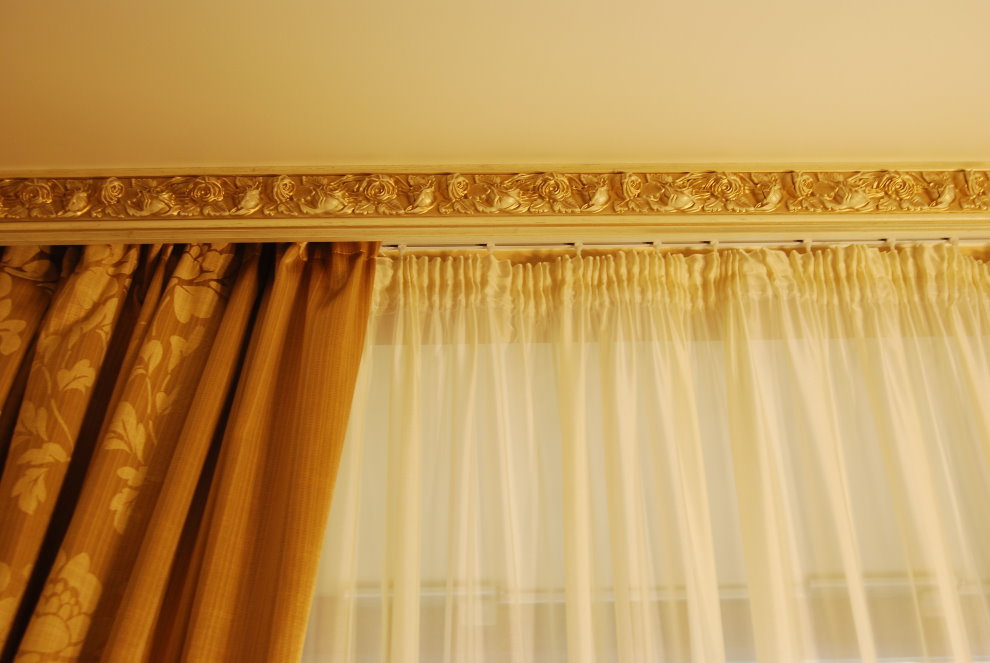
A framing molding, in contrast, serves as an interior decoration and is often used in a classic style.
Lambrequin Tulle
Lambrequin is a decorative longitudinal, wide strip of fabric. It serves for drapery and decoration of curtain composition. Lambrequins can be hung on profile cornices of triple modification or baguette designs with a special Velcro for lambrequins.

Tulle with pelmet looks good in large bright rooms
The combination of tulle with the interior of the room
When choosing tulle, it is necessary to take into account not only the color of the walls, the size of the area, lighting, but also the style of the interior. Each version of the room has its own version of the curtains:
- Modern style in the hall. Simple lines, symmetry, minimalism and laconicism are the main requirements for tulle in a hall with a modern design.The ideal option is a translucent monophonic fabric that harmonizes in color with the interior. A strip or light embroidery is allowed.

A plain canvas will serve as a backdrop for the interior and will become part of the decor, if selected in a contrasting color
- Classical. For the classic style, white, cream, beige colors are well suited. They can be combined with heavy curtains made of velvet, silk and a band with tassels. The top is often decorated with lambrequins. It is allowed to use patterns embroidered with embroidery.

A curtain of thin and transparent fabric will come in handy in the hall of the classical style
The pattern on the curtains should be in harmony with the wallpaper and curtains. If the interior and curtains are plain, then you can choose a tulle with rich decor. If there is embroidery on the curtains or a large pattern on the wallpaper, it is better to choose a plain tulle.
- Modern. In the tulle for the Art Nouveau style, two rules must be adhered to: layering and asymmetry. Layering is achieved by layering several curtains and curtains. Adhere to the rules of asymmetry will help lambrequins, asymmetric draperies and multi-level pickups, as well as randomly placed fabrics of different densities.
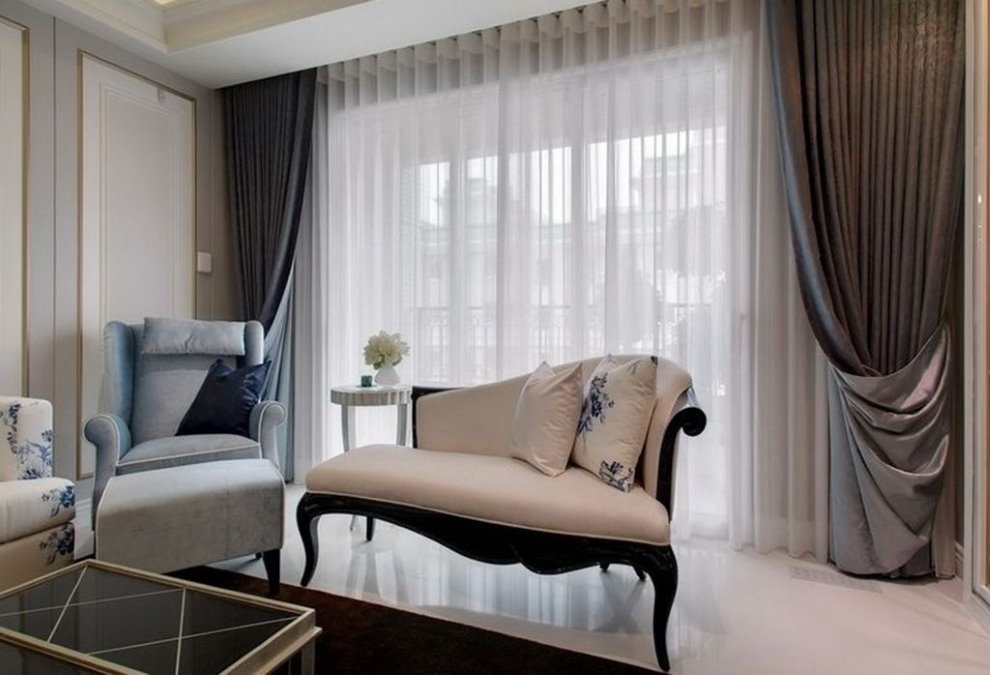
The combination of light curtains and blackout curtains in the modern style living room
- Provence. The style of the French heartland has been popular for many years. His charm and romance leaves few indifferent. For Provence, fabrics with a light texture that drape into the lush folds on the sides of the windows are suitable. On the canvas, floral patterns, embroidery, mesh weaving are possible.

For decoration of windows in a rustic style, a transparent white tulle with a discreet print is suitable
Photo tulle in rooms with different styles of interior will help to evaluate all the options and decide on the choice of curtains and curtains.
Video: A selection of photo examples of window decor tulle
Photos of tulle design ideas in the hall - 50 options
Designers offer a lot of options for using tulle for different dimensions of the room, interior styles, color schemes of rooms. Tulle and curtains for the hall, photos of which are included in the selection, clearly show how a room can be transformed due to airborne, translucent curtains.

